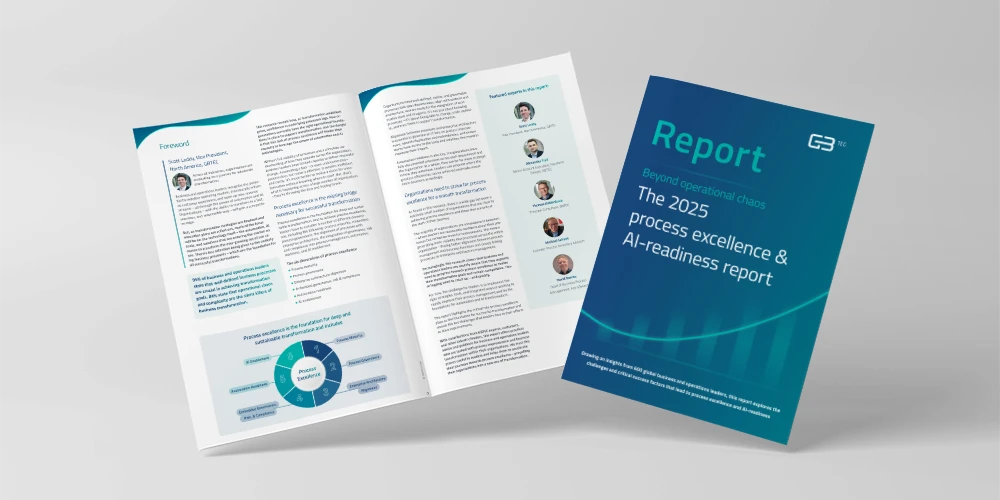Cutting through the chaos: What is Process Excellence and how it’s key for AI-readiness
While the world’s leading businesses race for digital transformation, new research reveals that their biggest blocker isn’t technology or the lack of it – it’s process complexity. Our 2025 Process Excellence and AI-Readiness research whitepaper provides insights gathered from 600 global business and operations leaders who all answered the same critical question: What separates organizations that thrive with automation and AI from those that stall – regardless of industry, geography, or company size?
This article summarizes key findings and insights from the whitepaper and also highlights common challenges many industries are facing and what solutions solve them. Whether you’re a boardroom executive, operations lead, IT architect, or transformation specialist, keep reading for the full blueprint on how to build an AI-ready organization that’s founded on true process excellence.
Technology and business processes – a necessary combo
Technology alone isn’t enough. Across all industries and regions, it’s clear to see that technology is only as powerful as the business processes that support it. To gain the true competitive edge in this AI era, organizations have to cut through the operational chaos by building transparent, governed, and adaptable processes. Once this is done, they can unlock sustainable transformation and business value at scale.

Unlock the Secrets to AI-Ready Transformation
Learn how top organizations build the foundation for successful AI and automation in our report Beyond Operational Chaos: Achieving Process Excellence for AI-Ready Business Transformation. Based on insights from 600 global business leaders, it reveals why clear, governable processes are key – and how operational chaos can quietly derail success. Download the full report to assess your organization’s readiness and start driving AI-driven growth.
One game-changing insight
95% say that well-defined business processes are crucial for hitting transformation targets, while 84% identify operational chaos as the silent killer of change.
This comes from conversations with 600 business and operations leaders across five continents and every major industry.
And while these organizations continuously invest in automation and digital solutions, most feel like they’re simply rolling the dice and hoping to win. But why is that? Why is the transformation journey still riddled with risk and disappointment?
Want the short answer? It’s because their foundations lack proper business processes – ones that actually keep up.
Despite most organizations being eager to grow and scale, they still lack the operational readiness, visibility, and alignment that’s required for meaningful transformation – especially in a world that’s quickly moving forward with AI. This results in siloed tools, competing priorities, wasted investments, and most significantly, a widening gap between leaders and laggards.
So, why is process excellence so important? It’s the key to business growth and the next greatest business differentiator – no matter the market, industry, or business model.
What makes a successful transformation?
Transformation is key to business growth. Our research shows the following:
- 31% of business leaders expect their organizations to transform at scale using automation and AI over the next two years.
- 78% predict major transformation programs will reshape business units, workflows, and business models around digital tools and AI.
It’s obvious the strategic intent is there, but the successful execution is missing. Only a fraction of these organizations will be successful, and the cost of failure is rising with operational setbacks, customer churn, regulatory risks, and lost market share.
The challenge: prioritizing both processes and tech
The research looks into the reasons behind transformation setbacks and highlights some of the common patterns that emerged, including:
- Lack of process visibility and current-state understanding: Organizations try to automate or optimize processes that are undocumented, siloed, or not fit for purpose.
- No single source of process truth: Nearly a quarter of leaders describe their process environments as either “fragmented” or “chaotic,” with multiple teams duplicating efforts and using incompatible tools.
- Overreliance on technology “quick fixes”: Companies deploy multiple BPM, workflow, and RPA platforms, but only a few integrate these for real, end-to-end visibility or improved outcomes.

However, the most telling finding was the following:
95% of respondents confirmed that even the best technology fails without robust business processes. Technology investment simply isn’t enough – unless paired with processes that are ready to support it.
The eight most common pain points organizations experience:
- Chaotic, inconsistent, or undocumented workflows
- Siloed teams with conflicting goals and KPIs
- Fragmented tool stacks and data environments
- No clear process ownership or accountability
- Difficulty measuring, managing, or improving process quality
- Low flexibility/adaptability in the face of regulatory or market shocks
- Wasted automation or AI efforts that fail to scale
- Unpredictable compliance and risk management outcomes
These pain points – also known as operational chaos – are not unique to any one region or market segment. It’s a universal headache, reported by leaders from manufacturing, finance, technology, healthcare, the public sector, and beyond.
What does Process Excellence really mean?
While process chaos is the main culprit of failed transformations, process excellence is what leads to successful business transformation. So, what is it? Our research defines process excellence as an organization-wide capability built on six interconnected pillars, which include:
The six pillars of Process Excellence
- Process Maturity
Organizations standardize, document, and continuously improve workflows – moving from ad-hoc or fragmented processes to systematized, data-driven routines. - Process Governance
Strategic alignment, accountability, ownership, and oversight at every level – embedding process roles and responsibilities throughout the business. - Enterprise Architecture Alignment
Business processes are designed and improved in partnership with IT, ensuring seamless integration with digital systems and complete lifecycle support. - Embedded Governance, Risk, and Compliance (GRC)
Risk and compliance aren’t layered on after the fact – they’re integrated into every aspect of process design, improvement, and execution. - Automation Readiness
Processes are fully mapped, measured, and prepared for automation – ensuring the right tasks are automated in the right ways and at the right times. - AI Enablement
Foundational processes are built to support intelligent automation and agentic AI – transforming advanced capabilities into concrete, safe, and scalable business value.

Process Excellence is not a “nice to have” – it’s an operating model for the future. It determines which companies can move fast, scale innovation, and leverage AI for sustainable advantage.
What are the key takeaways from the research?
Despite almost total agreement on the importance of process excellence, the research shows that most organizations are on the journey but have not quite arrived at their final destination:
- Only 17% rate themselves at the top “AI-powered” level of maturity
- About 29% operate with a truly “connected” process environment
- Almost 24% admit to high levels of process fragmentation or chaos
- Just 43% treat business processes as a strategic asset – while most view them as a necessary evil, an administrative task, or an IT problem
Many organizations believe that size, industry, or geography shapes their transformation journey, but the data would suggest otherwise.
What exactly does this mean?
- Visibility unlocks transformation
85% agree that business transformation fails without clear, end-to-end process visibility. Those with real-time views of processes are far more likely to succeed with both automation and AI. - Alignment is rare, but the risk is high
Fewer than half (49%) align their processes with tech, compliance, and critical value drivers. This gap impacts decision speed, regulatory compliance, and the ability to innovate. - Tool overload is stalling improvement
Most organizations juggle multiple BPM, workflow, and RPA tools, but poor integration undermines process visibility and prohibits cross-team collaboration. - GRC is still an afterthought
Almost a quarter (24%) of organizations do not consistently involve risk/compliance teams in process design – limiting their adaptability to regulation or security threats. - Agentic AI is coming fast, but few are ready
61% plan to integrate AI agents into their businesses in the next two years, but only 48% say their processes are ready for it.
87% stress that only structured, governed processes will enable these new AI models to be effective.
How to achieve AI-readiness with Process Excellence
- Embed process excellence into strategy, not treating it as a compliance function
- Build centralized, easily updatable process repositories (“a single source of truth”)
- Invest not just in digital tools, but also in governance structures, skill-building, and accountability
- Embed GRC from day one – enabling rapid, yet safe adaptation to risk and regulatory change
- Prepare, iterate, and standardize before going big with AI or automation pilots
Why is Process Excellence essential for all organizations?
- Every industry – from automotive and insurance to pharmaceuticals – experiences the same pain points, which are: a lack of standardized processes, misaligned tools, and silos that prevent innovation.
- Business leaders in every region – the United States, the UK, Germany, the DACH region, Benelux, and beyond – confirm the need for clarity, visibility, and integrated process management.
- Every function – whether operations, IT/digital, compliance, finance, or HR – within an organization is affected. Inadequate processes mean missed opportunities and amplified risks.
Process excellence is as foundational as financial discipline or cybersecurity in today’s market. In the age of AI and relentless change, those who fail to prioritize and build it will find – even in their best efforts – that their innovations are slow, costly, and ultimately unsuccessful.

What are the experts saying?
Alexander Trail, Senior Account Executive, Northern Europe, GBTEC
“It’s easy for business and operations leaders to be wowed by potential savings from new automation tools, but there are no guarantees – unless you have the right process foundations in place. Automation programs that aren’t aligned to process management are essentially flying blind. Leaders end up dealing with competing business cases for new automation tools and solutions based on siloed views of the organization.
Automation will only ever be as good as the underlying processes on which it is built. It may not be as glamorous or exciting as selecting and implementing new automation tools, but process mapping is just as important. If you have fully documented processes across each department and the organization as a whole, you can be far more strategic in how you automate. Leaders can see where the greatest efficiencies can be achieved and make investment decisions accordingly.”
Scott Leddy, Vice President, North America, GBTEC
“Standardization is essential for successful automation and agentic AI deployment. If 15 departments are doing things 15 different ways, you can’t train an AI agent on the optimal way to perform a task. Instead, the AI receives conflicting inputs, undermining its performance and reliability.
The starting point for a process-based approach to agentic AI transformation is to understand the current state first, document any variances, and work towards standardization. Then you can identify what tasks AI agents are going to handle and what they shouldn't touch, what data they will reference, and what documents they are going to create. Without this framework, agents can get confused and hallucinate, and that’s when you run into operational problems and severe risk.
Enabling AI integration within process management itself can be hugely powerful. For instance, AI can digest complex documents or procedural instructions and turn them into process maps within seconds. Instead of starting with a blank piece of paper,
you’re leveraging existing documentation to get an 80% ready process model, which you can easily refine. AI dramatically shortens the time required to model and document processes. You can iterate faster and, ultimately, achieve your transformation goals sooner.”
Ready to accelerate your journey to AI-powered operational excellence?
Discover how our platform can drive scalable business transformation and elevate your process excellence. Our experts are here to guide you every step of the way.






















